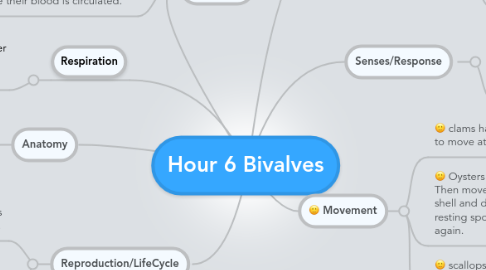Hour 6 Bivalves
by Karla Lockman

1. Respiration
1.1. They all breathe through their gills under the mantle and also filter water through siphons.
2. Anatomy
2.1. On the outside there's just a hard shell with a hinge that lets the shell open and close. They also have hing teeth. The main things inside them is their stomach, gills, and intestine. Along with other small organs.
3. Reproduction/LifeCycle
3.1. An oyster can live up to about four weeks and a mussel can live up to 20-100 years.
3.2. Sperm and egg are released during mating season from one male and one female, except for an oyster because they are hermaphrodites. The mussels and scallops sperm goes downstream for a female to pick up and after a few weeks, an organism develops.
4. Circulation
4.1. All have an open circulatory system. It starts from the heart being pumped and moves into some veins where their blood is circulated.
5. Feeding/Digestion
5.1. All are filter feeders which absorb nutrients from the water.
5.2. They eat mainly the plankton found in the water.
5.3. The food then passes through their esophogas, stomach, and then pass through the intestines and out the body. Both digested and undigested food may pass through.
6. Movement
6.1. clams have feet that allow them to move at a lateral angle
6.2. Oysters release larva, it moves until it finds a solid resting place. Then moves by extending a muscle, out of the front of their shell and drag themselves along the bottom until they find a resting spot. Once they find their resting spot they do not move again.
6.3. scallops have a rapidly contracting and relaxing abductor muscle
7. Senses/Response
7.1. Many have eyes around their shells that allow them to see their surroundings, and they have two rows of sensory organs that allow them to detect chemical and temperature changes, when they feel threatened they will close up their shells in order to protect themselves.


